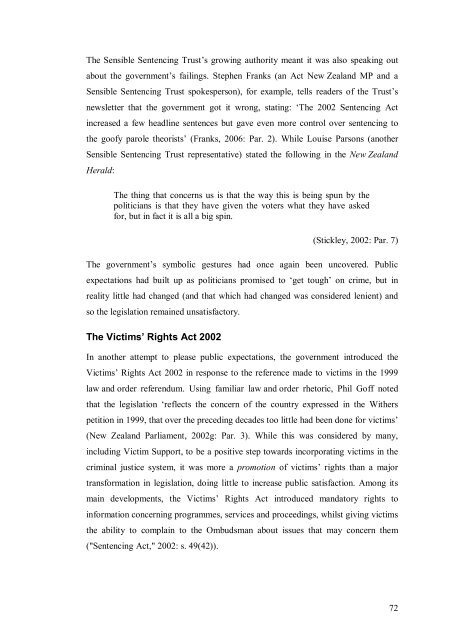By Tess Bartlett - Rethinking Crime and Punishment
By Tess Bartlett - Rethinking Crime and Punishment
By Tess Bartlett - Rethinking Crime and Punishment
You also want an ePaper? Increase the reach of your titles
YUMPU automatically turns print PDFs into web optimized ePapers that Google loves.
The Sensible Sentencing Trust’s growing authority meant it was also speaking outabout the government’s failings. Stephen Franks (an Act New Zeal<strong>and</strong> MP <strong>and</strong> aSensible Sentencing Trust spokesperson), for example, tells readers of the Trust’snewsletter that the government got it wrong, stating: ‘The 2002 Sentencing Actincreased a few headline sentences but gave even more control over sentencing tothe goofy parole theorists’ (Franks, 2006: Par. 2). While Louise Parsons (anotherSensible Sentencing Trust representative) stated the following in the New Zeal<strong>and</strong>Herald:The thing that concerns us is that the way this is being spun by thepoliticians is that they have given the voters what they have askedfor, but in fact it is all a big spin.(Stickley, 2002: Par. 7)The government’s symbolic gestures had once again been uncovered. Publicexpectations had built up as politicians promised to ‘get tough’ on crime, but inreality little had changed (<strong>and</strong> that which had changed was considered lenient) <strong>and</strong>so the legislation remained unsatisfactory.The Victims’ Rights Act 2002In another attempt to please public expectations, the government introduced theVictims’ Rights Act 2002 in response to the reference made to victims in the 1999law <strong>and</strong> order referendum. Using familiar law <strong>and</strong> order rhetoric, Phil Goff notedthat the legislation ‘reflects the concern of the country expressed in the Witherspetition in 1999, that over the preceding decades too little had been done for victims’(New Zeal<strong>and</strong> Parliament, 2002g: Par. 3). While this was considered by many,including Victim Support, to be a positive step towards incorporating victims in thecriminal justice system, it was more a promotion of victims’ rights than a majortransformation in legislation, doing little to increase public satisfaction. Among itsmain developments, the Victims’ Rights Act introduced m<strong>and</strong>atory rights toinformation concerning programmes, services <strong>and</strong> proceedings, whilst giving victimsthe ability to complain to the Ombudsman about issues that may concern them("Sentencing Act," 2002: s. 49(42)).72
















